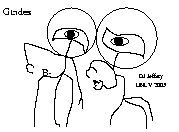
Engineering Physics 211L (Section 1): University of Idaho: 2009 Summer
The course mottos: very reassuring I think.
Sections
This syllabus is subject to change at the discretion of the instructor. Any changes will be announced in class as well as made on this page.
which is the page you are maybe viewing right now.
This page is the preliminary syllabus and includes
syllabus items
and the tentative schedules:
Tentative Schedule I for 211L
and
Tentative Schedule II for 212L.
This page is/will be/may be linked from the official physics department
course web page.
Both as per the
Physics schedule.
Let's just say:
For Physics 212L, the
pre/corequisite is Physics 212.
We will learn some physics.
We will learn some hands-on physics.
We will learn some data analysis techniques: plotting, significant figures, error analysis.
We will have fun.
But one just accepts that and digs in for the long haul.
The format, grading, due dates are all at
General Laboratory Policies.
Labs themselves are described in
the Lab Manual.
But not fully.
Additional description is pretty always needed in the lab itself.
Other information can be found online below on the
and the tentative schedules:
Tentative Schedule I for 211L
and
Tentative Schedule II for 212L.
To the General Laboratory Policies,
I make some additional remarks and adjustments.
Attendance is KEPT.
No lab is done, unless you have done it.
This is a participation class.
Your mark on labs will be based on preparation for the lab, performance in lab, and
on completeness, conciseness, understanding, correct analysis, and neatness of the reports.
Don't be
circumloquacious.
Remember your
Elements of Style
just like they teach you in freshman writing.
Not many words are needed for data and results, but the data and results
should be followable.
Conclusions do not have to be excessively long, but you must cover what you
have learnt in the experiment.
You should say if the theory has been verified or not.
If not, give some discussion to why not.
Suggestions for further experimentation on the theory or with the
equipment are recommended.
Answer any explicit questions from
the Lab Manual
For me, lab reports do NOT have to word processed.
Handwritten reports are adequate.
No lab report is considered done, unless the student has physically done the lab.
The instructor must initial your data sheet before you leave the lab.
The labs are due one week after completion.
This is a lab course. Doing the lab is a vital component.
Students are encouraged to help each other out both in the lab and in writing
the reports.
But there should be NO straight copying from each other.
It two identical lab reports come in, there's only one mark and it's
split between the two coauthors.
The instructor is also available for help, of course.
There will be a make-up lab period near the end of the semester.
Letter grades will be assigned
per
UI catalog---which allow instructors some freedom of
interpretation.
The instructor uses a curve to automatically
assign letter grades during the semester---if there are enough
students to make a curve meaningful---if there arn't, the instructor
just decides on letter grades.
There is NO fixed scale.
The final grades are decided on by the instructor directly---the curve
is NOT used, except as a guide.
Students can always ask the instructor for their current
mark record and letter grades.
Queries by email are probably best for this.
The instructor will submit MIDTERM GRADES and FINAL GRADES
as scheduled in the
academic calendar---which
doesn't specify any midterm grade dates for summer courses.
Remember that after an instructor has submitted FINAL GRADES,
any adjustments (except for purely clerical errors) are
NOT allowed by university policy.
http://physics.nhn.ou.edu/~jeffery/course/c_intro/intrl.html
NO PHYSICS DEPARTMENT TUTORING FOR SUMMER CLASSES.
For Physics 211L, the
pre/corequisite is Physics 211.
In the , there's the mindnumbing monotony of 2 labs a week
for 8 weeks with maybe a couple of days off.
Safety (Wolfson & Pasachoff, p. 687)
---------------------------------------------------------------
Current Range Human Effect
(mA)
----------------------------------------------------------------
0.5--2 threshold of sensation
10--15 involuntary muscle contraction; can't let
go of source
15--100 severe shock, loss of muscle control,
difficulty breathing
100--200 fibrillation of the heart, death within minutes
>200 cardiac arrest, breathing stops, severe burns
----------------------------------------------------------------
Tip: If you are outside and your hair starts standing on end,
get out of that place.
Note conciseness.
Introductions should be brief. The experiment is described in
the Lab Manual
or other sources.
The introduction should say what the experiment is study: often this is to test some theory
or demonstrate the behavior of equipment.
The procedure of the lab should be mentioned, but not described in any length.
Do put your equipment away before asking for initials.
The instructor may ask for new measurements.
The labs will be marked out of 20.
It is best not to miss any labs, but don't miss two.
lab reports 100 % or less no drop
lab quizzes 0 % or more no drop
There are absolutely NO extra credits.
See
Policy on Grades from the
UI Catalog.
Note that E-6 states that grade changes after instructor submission are
only allowed for clerical corrections, not for reweighting or additional work.
There is another avenue for grade emendation:
the Academic
Hearing Board (1640.02 C-4) can have a say on grades---but it's not
very promising.
 Beware of aliens bearing grades.
Beware of aliens bearing grades.
There are 13 labs scheduled, but we might add one more.
Each lab has a number, except for ones not in the Lab Manual.
The labs are NOT in order.
The dates for labs have been/will be assigned.
There are 13 labs.
Each lab has a number, except for the one in the Lab Manual.
The labs are NOT done in order.
The dates for labs have been/will be assigned.